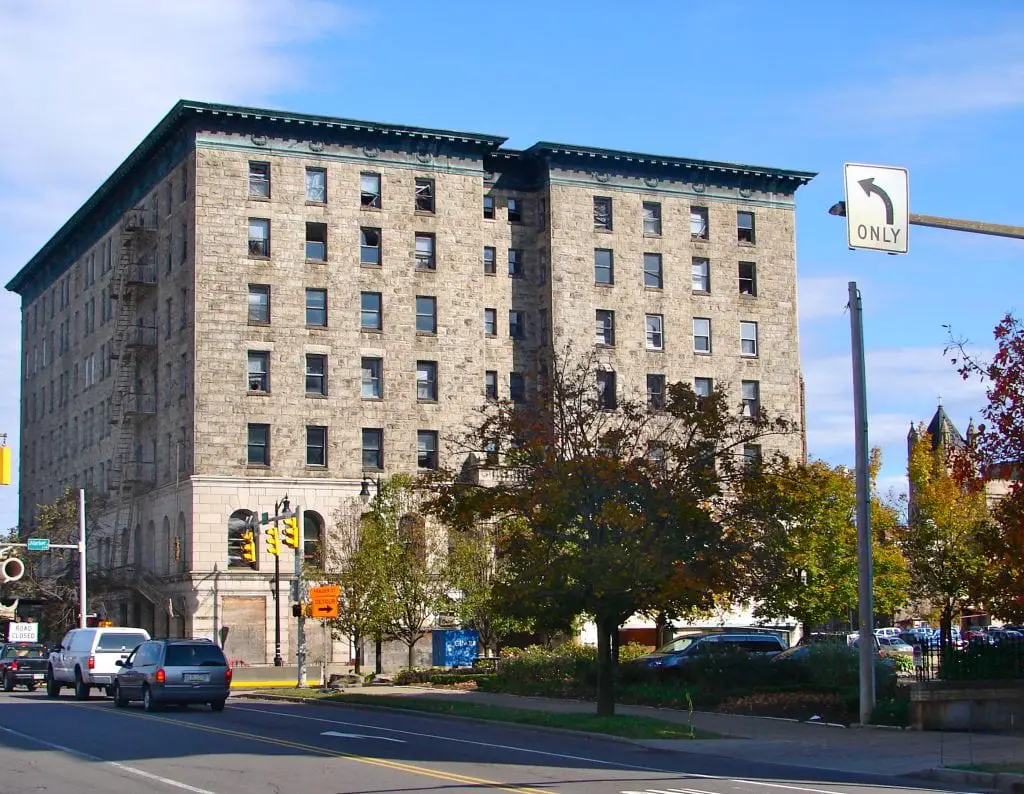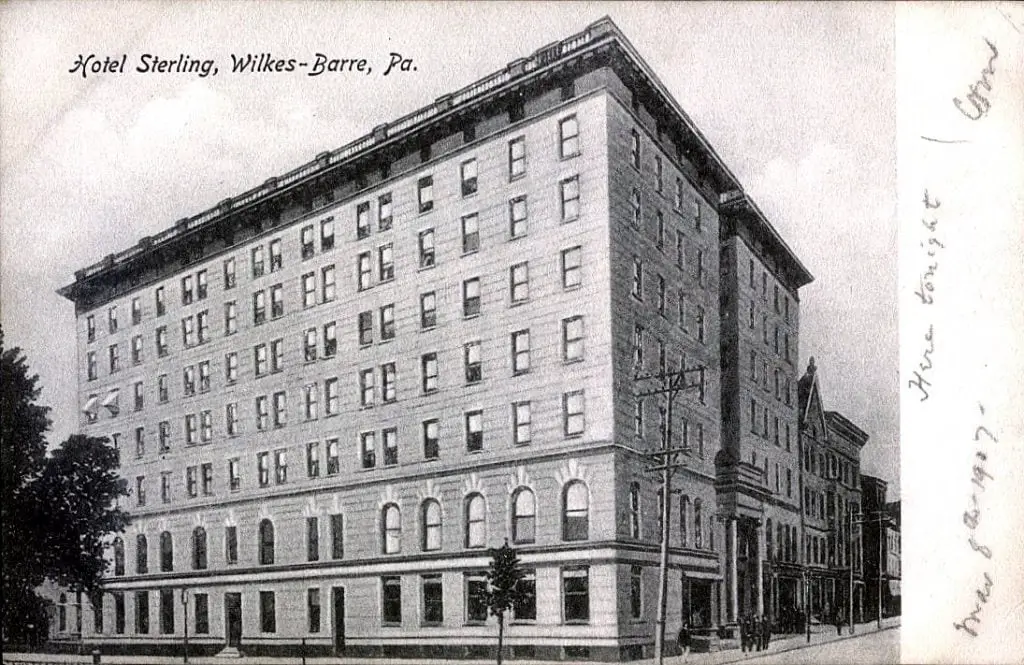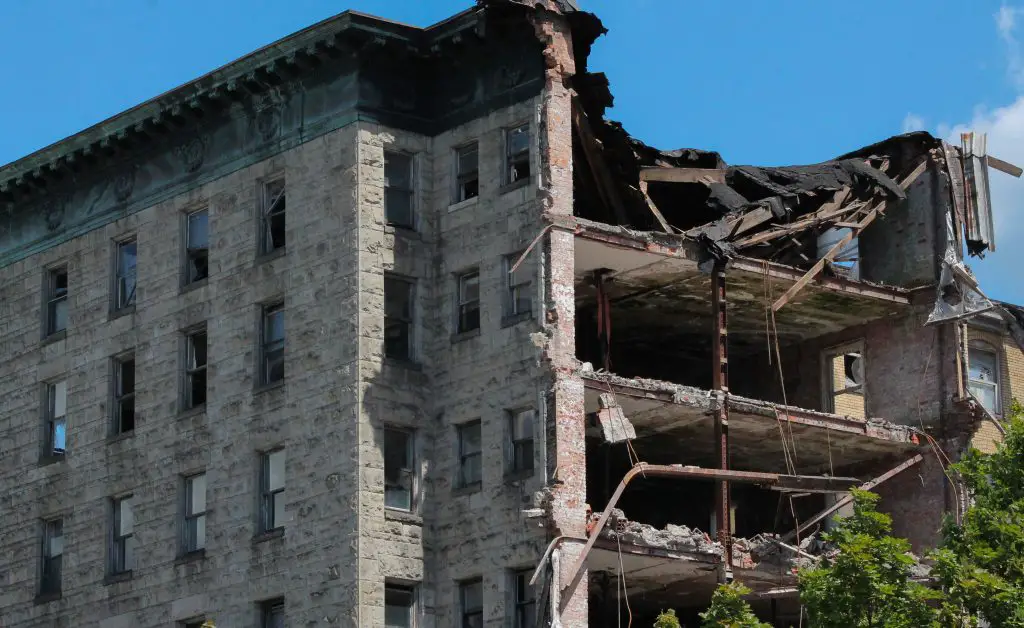The Birth of Hotel Sterling
In the bustling heart of downtown Wilkes-Barre, Pennsylvania, at the crossroads of River Street and Market Street, a grand tower known as the Hotel Sterling once stood.
This architectural marvel was more than just a hotel; it was a symbol of the city’s prosperity, a testament to the vision of its founders, and a beacon of luxury and comfort for visitors and locals alike.
The Hotel Sterling was the brainchild of a group of local businesspeople who 1898, envisioned a grand hotel that would serve as a cornerstone of the city’s burgeoning hospitality industry. The hotel was named after Emma E. Sterling, a woman of remarkable determination and vision.
Emma, whose late husband, Walter G. Sterling, was a prominent local banker and businessman, played a pivotal role in the hotel’s creation. Her influence was so profound that the hotel was named in her honor, a tribute to her indomitable spirit and dedication.
At the time of the hotel’s inception, Wilkes-Barre and the surrounding region were significant sources of anthracite coal. This industry was the city’s lifeblood, and the prosperity it brought was reflected in the grandeur of the Hotel Sterling.
The hotel’s establishment marked a significant milestone in the city’s history, symbolizing the economic growth and development that was taking place.
The Sterling’s Heyday
The Hotel Sterling’s heyday coincided with the first half of the 20th century, a period of economic prosperity and growth for Wilkes-Barre.
The hotel symbolized the city’s success, attracting visitors from far and wide. During this period, the hotel became its own, a beloved institution and a cornerstone of the city’s identity.
In the 1920s, Homer Mallow, the company’s majority stockholder, and president, further bolstered the hotel’s fortunes.

Under Mallow’s leadership, the hotel became known as the Mallow-Sterling, a name that resonated with luxury and prestige. Mallow’s stewardship marked a golden era for the hotel, with its reputation for luxury and service reaching new heights.
However, the Mallow-Sterling faced competition in 1923 with the opening of the Hotel Plaza, a towering structure designed by the New York architectural firm of Warren and Wetmore. Despite the competition, the Hotel Sterling remained a beloved institution, eventually acquiring the Hotel Plaza in 1927.
This acquisition marked a significant milestone in the hotel’s history, creating the “Sterling Hotels System” and solidifying its position as a leading hospitality establishment in the city.

Architectural Marvel and Expansion
The architectural design of the Hotel Sterling was a testament to the creativity and ingenuity of its time. Local architect J. W. Hawkins was tasked with designing the hotel. His initial design, a European chateau-like structure, was rejected.
However, his revised design, a modern tower with a limestone facade, was accepted and became the iconic image of the Hotel Sterling. The hotel’s architecture, intricate detailing, and grand scale reflected the city’s ambition and optimism.
In 1936, the hotel underwent a significant expansion under the guidance of Andrew Sordoni. Sordoni, who previously served as a state senator and titan in the construction industry, linked the Hotel Sterling with the Plaza Hotel, amplifying its prestige and accommodation capacity.

This expansion marked a new chapter in the hotel’s history, transforming it into a larger, more comprehensive hospitality establishment.
Decline and Closure
Despite its illustrious history, the Hotel Sterling was not immune to the economic shifts of the mid-20th century.
The decline of the anthracite coal industry, which had been the backbone of Wilkes-Barre’s economy, profoundly impacted the hotel’s fortunes. As the city’s economic landscape changed, so too did the ends of the Hotel Sterling.

Over the following decades, the Sterling experienced a gradual decline. Changes in ownership and the shifting economic landscape of the city led to its eventual closure in 1998.
The once bustling hotel, symbolizing Wilkes-Barre’s prosperity, was now a silent monument to a bygone era. The closure marked the end of a period, a poignant reminder of the city’s past and the transient nature of success.
Demolition and Aftermath
In 2002, the Hotel Sterling was purchased in a tax sale by a non-profit organization named CityVest. The organization had plans to restore the hotel, but these plans were not realized. Rather than preserving the entire structure, sections of the hotel were torn down to appeal to prospective developers.
Despite these efforts, the hotel failed to attract investors. The decision was made to demolish the remaining original hotel. The demolition began on July 25, 2013, and by July 30, the once-grand Hotel Sterling was no more. The demolition marked the end of an era, a poignant reminder of the city’s past and the transient nature of success.
Today, the site where the Hotel Sterling once stood serves as a reminder of the city’s past. It is a testament to the ever-changing nature of cities and the enduring legacy of the structures that once defined them. The site is a poignant reminder of the city’s history, a symbol of its past, and a beacon of its future.
Future Plans for the Hotel Sterling Site
The site where the iconic Hotel Sterling once stood is set to undergo a significant transformation. Plans are underway for a new hotel and conference center, a development that promises to breathe new life into this historic location in downtown Wilkes-Barre.

The development group behind the project, H&N Investments LLC, has faced some delays due to the ongoing COVID-19 pandemic. However, the state has shown its commitment to the project by awarding another grant, bringing its total funding to $6.5 million.
The proposed development includes a 110-room Hyatt Place Hotel and conference center. However, the project’s costs have increased by 25% due to the pandemic. Even though the developer missed the initial construction start date of September 1, 2021, due to the pandemic, the city has agreed to review any proposed changes to the timeline.
The development of the Hotel Sterling site is a significant undertaking, but it holds the promise of revitalizing a vital part of downtown Wilkes-Barre. As plans unfold, the city awaits the rebirth of a site that once had a beloved landmark.
Bundle your hotel + flight together to save more on your next trip! Book now at Expedia.com

